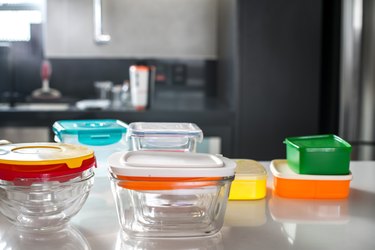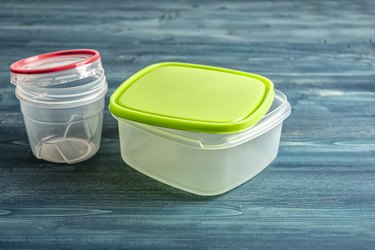
When vinyl and plastic items are used over time, they can start to develop a "foggy" or "cloudy" appearance. Similar materials can also start to lose their shine, but cleaning cloudy plastic or dingy-looking vinyl is easy. You can make your old blender, plastic storage containers or jars look like new again with a few clever tricks.
Preparing Plastic Before Cleaning
Video of the Day
Soap and water is good for cleaning many things, but it may not be the best choice for cloudy plastic. This is partially because soap can leave a film. In addition, water can leave mineral deposits that are hard to remove. The worst thing to use on plastic is an abrasive cleaner or rough cleaning tools like steel wool. These can easily scratch the plastic and make it even cloudier.
Video of the Day
You will first want to remove any debris from the plastic with some dish soap and hot water. Most plastic containers can be cleaned in the top rack of a dishwasher, but over time the pieces can get warped, melted or otherwise damaged.
Cleaning Cloudy Plastic
One of the best ways to clean cloudy plastic is to use that old standby: vinegar. Fill up your kitchen sink with a few cups of white vinegar and hot water, separate your plastic pieces and let them soak for at least 10 minutes. Then, drain the sink and rinse everything with more hot water.

Another way to clean cloudy plastic is to use a paste of baking soda plus vinegar. After you have done the initial pass-through with soap and water, sprinkle in about a 1/2 teaspoon of baking soda and drip in enough hot water to create a paste. Scrub gently with a coarse (not abrasive) sponge and add a bit of vinegar.
You will see it begin to bubble up; scrub a little more to disperse the baking soda and vinegar. Pour in enough hot water to fill the container. You can let it sit for about 30 minutes, but for more cleaning power, allow it to sit overnight.
After soaking, rinse it well with more hot water and dry with a clean cloth. The plastic should be sparkling clean at this point. You can also clean cloudy plastic with hand sanitizer, rubbing alcohol or lemon juice – these are also good for getting rid of tomato sauce and coffee stains. Always dry off the items with a clean, soft cloth and let them air dry to make sure there is no moisture left. If none of these methods work, try a commercial a plastic cleaning product, which can work on plastic as well as on acrylic, vinyl and Lucite.
Scratches on Clean Plastic

If you see any scratches on the clean plastic, check how deep the damage is before proceeding. Small scratches that don't go past the surface can often be buffed out with a mixture of baking soda and water or toothpaste. Just apply either to a toothbrush, and scrub gently in a circular motion.
For deeper scratches on items like blenders, headlights or plastic furniture, try using a fine 220/320-grit sandpaper or a heat gun on its lowest setting. Do not use paper towels on acrylic, vinyl or Lucite as their abrasive surface can cause scratch marks.